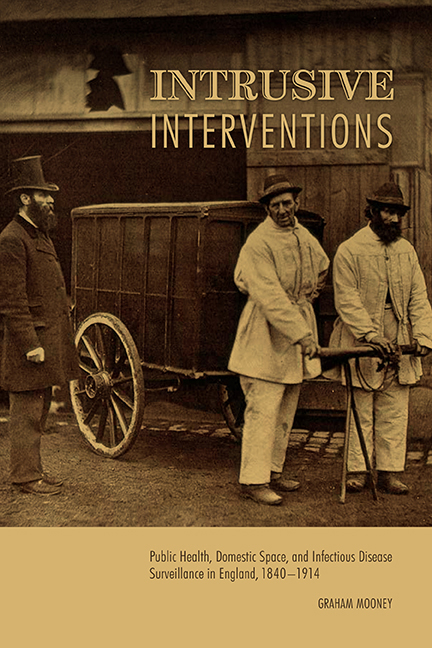 Intrusive Interventions
Intrusive Interventions Book contents
- Frontmatter
- Dedication
- Contents
- Acknowledgments
- Abbreviations
- Introduction
- Part One Making Infectious Disease Surveillance
- Part Two Spaces of Risk and Opportunity
- 3 Sequestration and Permeability: Isolation Hospitals
- 4 “Combustible Material”: Classrooms, Contact Tracing, and Following-Up
- 5 Disinfection, Domestic Space, and the Laboratory
- 6 Rules for Home Living: Tuberculosis and the Consumption of Self-Help
- Conclusion
- Notes
- Bibliography
- Index
5 - Disinfection, Domestic Space, and the Laboratory
from Part Two - Spaces of Risk and Opportunity
Published online by Cambridge University Press: 14 March 2018
- Frontmatter
- Dedication
- Contents
- Acknowledgments
- Abbreviations
- Introduction
- Part One Making Infectious Disease Surveillance
- Part Two Spaces of Risk and Opportunity
- 3 Sequestration and Permeability: Isolation Hospitals
- 4 “Combustible Material”: Classrooms, Contact Tracing, and Following-Up
- 5 Disinfection, Domestic Space, and the Laboratory
- 6 Rules for Home Living: Tuberculosis and the Consumption of Self-Help
- Conclusion
- Notes
- Bibliography
- Index
Summary
A peculiarly Victorian disquiet centered on the materiality of domestic life. The disease-harboring threat of furnishings and decorations had been long acknowledged by medical authorities on the sickroom. Writing in the 1840s, elite physician Anthony Todd Thomson argued not only that infection settled in clothes and bedding made from wool, cotton, and fur, but that it also clung to floors, furniture, and ornaments, especially if these objects had rough and unpolished surfaces. Advice from physicians like Thomson remained a feature of home nursing manuals throughout the Victorian period. Removing superfluous furniture and ornamentation formed part of the ritual that signified the sickroom as a space of separation and seclusion within the home. Domestic patient management both during and after the episode of illness featured the regular cleansing of floors, walls, fixtures, and fittings with soap and water, washing with a solution of chloride of lime or other chemical agents, and fumigation. However, the potential risk posed by furnishings extended beyond the sickroom and included the entire domestic space. According to Eileen Cleere:
The Victorian home was under increased pressure in the second half of the nineteenth century to appear hygienically inviolable, impermeable, and unassailable. Yet after the development and general acceptance of germ theories in the 1870s, the impenetrable Victorian home became an anxious fantasy rather than a predictable ideological construct…. Mid-Victorian sanitary geographies of the city turned inward, eventually producing analogous geographies of the overdecorated, architecturally busy middle-class interior.
One might quibble with Cleere's chronology, the ubiquity of germ theory's acceptance, and its impact on public health policy, but the general point remains. The proliferation of nooks and crannies in the Victorian home gave safe haven to the detritus of life and harbored the threat of death. This preoccupation with spotlessly clean domestic interiors was something of a new twist in the politics of the sanitary home. To understand why, it is necessary to appreciate the complex interplay of multiple “liberalisms”: liberal notions about the relationship between the individual and the state; liberal political economy; and liberal governmentality.
- Type
- Chapter
- Information
- Intrusive InterventionsPublic Health, Domestic Space, and Infectious Disease Surveillance in England, 1840-1914, pp. 121 - 153Publisher: Boydell & BrewerPrint publication year: 2015


